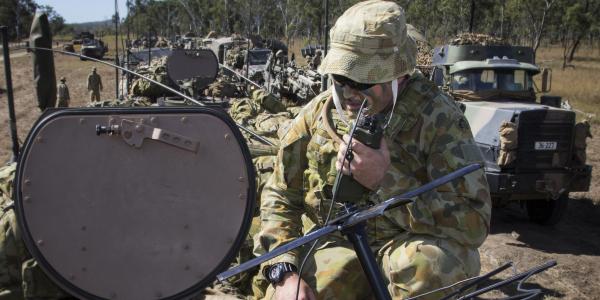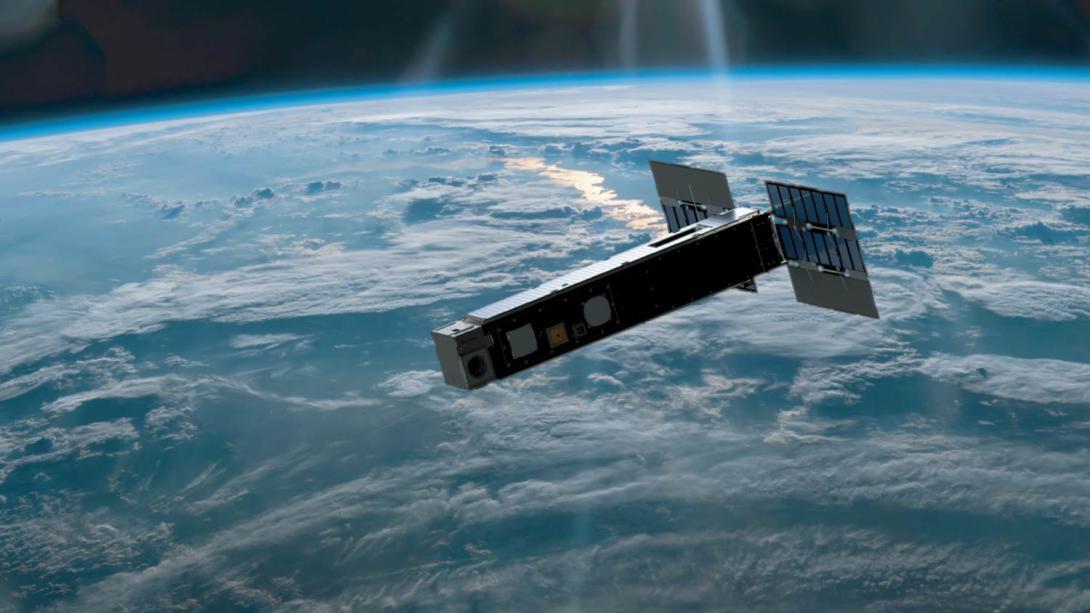No Backing Down On Interoperability Down Under
Australia is drawing on relationships with its closest allies to improve the interoperability of communications and information systems with nontraditional partners. Large-scale programs among allies as well as formal alliances are creating the basis of efforts to ensure bilateral collaboration in contingency operations. These efforts come amid Australian programs to modernize the country’s communications and networking technologies across the spectrum of military operations.
Australia’s top three communications and information systems (CIS) priorities are to ensure that systems are modernized, enable the full capabilities of new platforms introduced into service, and resist cyber and electronic warfare (EW) threats, says Air Vice Marshal Andrew Dowse, RAAF, head of the Information and Communications Technology (ICT) Operations Division and Strategic J-6, Australian Department of Defence.
AVM Dowse says modernization largely will take the form of replacing legacy applications and operating systems, along with hardware. Upgrades are being applied across the board, from the military’s strategic corporate environment to its technical environment. Replacing dated systems has become more difficult as technology cycles shorten, he points out. He cites completion of the move off of Windows XP as a high priority.
Many systems already have been modernized as part of this ongoing effort, but much remains to be done as new technologies emerge, rendering others obsolete. This endeavor is further complicated by the dependencies between hardware and old operating systems, the air vice marshal points out. “If you don’t upgrade your operating system, you have to go and look for hardware sometimes even on eBay,” he allows. Similarly, old applications often do not work on modern operating systems. Replacement must be carefully coordinated, he adds.
Modernization efforts come against a backdrop of growing concerns about cyberthreats and EW waged against Australian CIS. The military views the two disciplines as similar in terms of countering an adversary’s ability to conduct information operations, AVM Dowse offers.
“Ensuring the security of our systems is something we see as a huge priority,” he declares. “If we’re not mindful of our cybersecurity, we will face a strategic surprise in the future. So, we’re trying to do everything we can to achieve the balance between accessibility and security.
“If we stray too much from one side—if we’re too free with access, we will suffer from security,” he continues. “If we are too stringent on security, we won’t be able to do the things we need with our CIS in the future.”
Among the military’s countermeasures are ensuring redundancy and hardening systems. Another aim is to fit the appropriate system to mission criticality. This way, less complex but more vulnerable systems would not be placed in an operation where they could end up being an Achilles’ heel in enemy cyber or EW attacks.
Australia relies a great deal on industry for providing services and keeping the military aware of technology choices, AVM Dowse notes. Much of the country’s CIS employs off-the-shelf technology, so forces must keep abreast of technology evolution in industry. The military is making far greater use of mobile technologies, he adds, and it is altering its CIS architecture to increase virtualization with thin clients and consolidated data centers.
Overall, Australia is working toward greater integration of its networks and deployed mobile platforms. This will enable forces to be well-informed and integrated, AVM Dowse says. But it requires a substantial investment. And, with increased connectivity come increased dependency and vulnerability, so Australia’s CIS will need to be more resilient. Mutually supportive cybersecurity activities with Australia’s allies will help in this area, AVM Dowse notes.
With Australia’s area of interest comprising the vast Indo-Pacific region, communications and networking reach is important, particularly beyond-line-of-sight communications. The country’s primary means of overcoming the tyranny of distance is satellite communications (SATCOM), the air vice marshal states. “Our SATCOM is much improved through our cooperation with the United States, but we have challenges,” he states.
These include aligning ground, space and terminal segments, coping with increasing demand for bandwidth, competing for geostationary filings and ensuring system resilience. To meet these challenges, Australia is developing a plan called JP 9102 that will address all aspects of the country’s military SATCOM from the mid-2020s to 2040. The plan aligns with the country’s requirement to develop a follow-on capability to today’s Wideband Global SATCOM (WGS) and narrowband SATCOM systems. Australia also is participating in the U.S. analysis of alternative wideband SATCOM activities. He expects greater clarity in the direction of JP 9102 in the 2019-20 time frame for a subsequent series of project approvals in a rolling program.
AVM Dowse explains that Australia has been working closely with the United States on SATCOM to ensure that both nations are aligned and can remain interoperable. This also permits both to exploit the synergies and partnerships of programs such as the WGS, where they share SATCOM resources.
He adds that commercial SATCOM technologies are advancing rapidly, especially in terms of agility and support for capabilities such as service on demand and SATCOM-on-the-move. Commercial systems actually are better than their military counterparts in these two areas, the air vice marshal notes. “We need to take the best of breed from military and commercial SATCOM in our future capabilities. That means we use both, or we take technologies from either one and employ them in the other. The plan will inform us of [those choices],” he says.
For military use of space, Australia maintains a strong relationship with the United States. The two nations cooperate specifically in sensing, communications and precision navigation and timing. In CIS, they partner in wideband, narrowband and anchoring arrangements, AVM Dowse notes. Australia also increasingly cooperates with the United States in space operations, particularly in introducing capabilities for space situational awareness. “We are assisting collective partners in terms of providing information from our part of the world insofar as what we can see in space and how we can inform people, particularly to avoid conjunctions of assets in space,” he states.
Australia is closely engaged with the United States on overall Indo-Pacific security matters as well. Both countries have a long-standing security relationship that supports collaborative development of solutions to interoperability challenges encountered on coalition operations. Australia is working closely with the U.S. Pacific Command (PACOM) to ensure multilateral approaches to interoperability wherever and whenever possible. He observes that this is not always possible for various reasons.
Australia and PACOM also strive to ensure coordination when both countries are engaged in bilateral activities. AVM Dowse points out that the multilateral Combined Communications-Electronics Board is an example of the close relationship between allies on CIS matters, but other forums are focused on more specific aspects of interoperability. Through these types of engagements, the two nations can achieve a high level of trust and connectivity among command, control, communications, computers, intelligence, surveillance and reconnaissance (C4ISR) and other systems.
Seeking to expand their interoperability, the United States and Australia conduct a range of exercises to further develop, test and refine their ability to carry out military operations together. Exercise Talisman Sabre is a biennial activity to test bilateral interoperability in a series of challenging near-peer warfighting scenarios. “That exercise has benefited from the support of the U.S. Coalition Interoperability Assurance and Validation (CIAV) team, which is a valuable asset that has improved the interoperability between our forces,” AVM Dowse says.
One valuable lesson gleaned from that exercise is the importance of validation in ensuring interoperability in likely collaborative scenarios, he continues. “By [identifying] all the bugs in that exercise, we are far more capable and prepared to undertake real operations together,” the air vice marshal says.
Bilateral and multilateral arrangements with other nations also aim to improve interoperability. One of these comes from the other side of the Earth. The NATO Federated Mission Networking (FMN) framework, which Australia is affiliated with, is an important initiative in this vein. The FMN framework will help participating nations achieve interoperable systems to facilitate rapidly formed ad hoc coalitions. With the FMN establishing standards, interoperability will occur with the support of standardized episodic mission partner networks, AVM Dowse states.
In addition, Australia must develop effective interoperability with its regional partners. “We don’t have good, secure communications with many of these regional partners, and many of them aren’t involved in interoperability forums such as FMN,” he declares. The country has a range of forums to look at interoperability issues. “Arrangements such as FMN with regional nations will be critical in future, as we don’t want to be trying to develop interoperability when we are responding to a crisis.”
The air vice marshal continues that much of Australia’s attention over the past 15 years has been focused outside the region. Now it is refocusing its engagement activities with regional partners—bilaterally, multilaterally and especially in conjunction with PACOM. A great deal of this engagement recognizes the importance of CIS cooperation and development of interoperability, whether that is through dialogue, cooperative development, exercises or operations.
Australia already has a deployable mission partner network that will be used in some regional activities over the next couple of years, AVM Dowse reports. Potential applications include regional elections in which Australia might be called upon to assist as well as contingencies such as a disaster requiring humanitarian actions. Initiatives such as the FMN strive to “get ahead of the game” in preparing for interoperability before these operations, he says.
“Like the United States, we are working hard to develop mission partner network arrangements so that we can host or integrate with regional forces in exercises and operations in support of missions that may range from humanitarian assistance to conflict situations,” AVM Dowse emphasizes.
He notes that while most nations seem to prefer bilateral agreements, many do not want a high level of interoperability in a conflict scenario. Consequently, Australia and these nations are achieving interoperability for noncombat operations such as humanitarian assistance and disaster recovery.
This is in keeping with the core of interoperability. “It’s all the processes that sit on top of the CIS, all of the functionality of the applications that you need to validate as well,” AVM Dowse states.






Comments